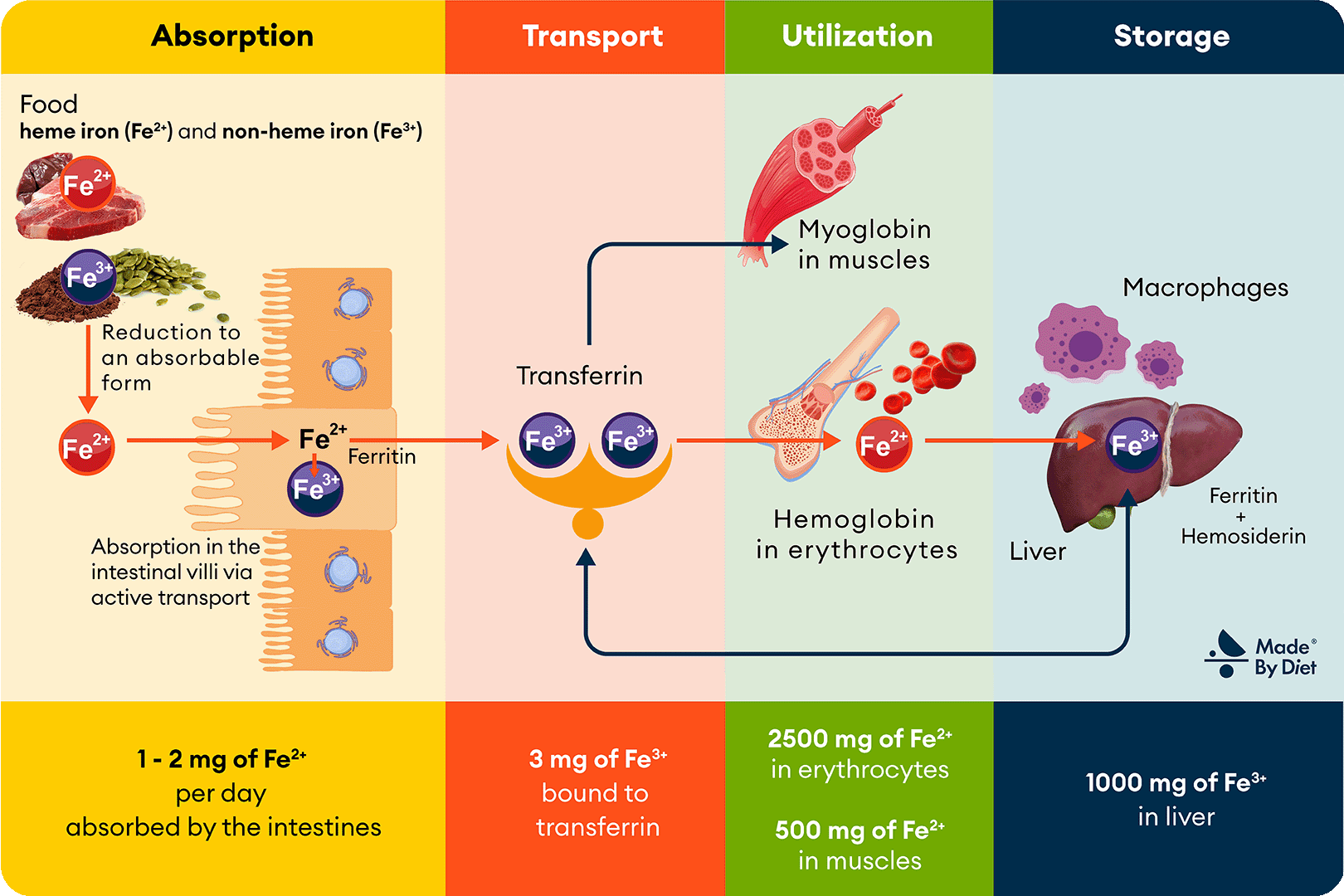Did you know that millions of people worldwide suffer from vitamin D deficiency – without even realizing it? If you often feel tired, get sick frequently, or struggle with unexplained aches, low vitamin D could be the hidden culprit. This issue becomes even more pressing in fall and winter when shorter days and weak sunlight make it nearly impossible for your body to produce enough of this essential nutrient. And the consequences? A weakened immune system, chronic fatigue, and an increased risk of serious conditions like osteoporosis, diabetes, and heart disease. But here’s the good news: you can take control. Do you know your optimal vitamin D levels? Are you getting the right dose of cholecalciferol to stay healthy and energized? Proper supplementation isn’t just about preventing deficiencies – it can significantly improve your overall well-being and help protect against a range of diseases. In this article, we’ll uncover why vitamin D insufficiency is a global problem, from Europe to the USA, and what you can do about it. You’ll learn how to test your levels, the latest expert-backed supplementation guidelines, and how to fine-tune your intake based on your age, lifestyle, and location. Let’s make sure you’re getting enough of this vital nutrient – starting today!
Authors: MSc Klaudia Buczek, MSc Pharm. Michał Miśta
Table of Contents:
- What Role Does Vitamin D3 Play in the Body?
- How Does the Body Acquire Vitamin D?
- Vitamin D Metabolism
- Why Is Diet Alone Insufficient for Vitamin D Intake?
- Vitamin D3 Supplementation
- How to Measure Vitamin D Levels and When to Do It?
- New Guidelines for Vitamin D Supplementation
- Effects of Vitamin D Deficiency
- Excess Vitamin D3
- Summary: Why Is Vitamin D3 Essential for Health?
- References
1. What Role Does Vitamin D3 Play in the Body?
Vitamin D3, also known as cholecalciferol, is a fat-soluble vitamin that plays a crucial role in many of the body’s biological processes. It is unique because the body can synthesize it in the skin when exposed to ultraviolet B (UVB) radiation from sunlight. The functions of vitamin D in the body go far beyond its commonly known role in bone health! It helps regulate immunity, supports proper functioning of the heart and blood vessels, and aids metabolism. A deficiency in vitamin D3 can not only weaken the body and cause fatigue but also increase the risk of serious chronic diseases.
Impact on Bone and Muscular Health
One of the most important functions of vitamin D is supporting the proper absorption of calcium and phosphorus from the gastrointestinal tract, which is essential for the mineralization of bones and teeth. This helps vitamin D3 prevent conditions such as osteomalacia in adults and rickets in children. Furthermore, maintaining adequate vitamin D3 levels supports muscle function, reduces the risk of injuries, and enhances physical performance.
Role in the Immune System
Cholecalciferol plays a vital role in regulating the immune system. It helps reduce inflammation and supports the body in fighting infections. Research indicates that vitamin D supplementation reduces the incidence of autoimmune diseases such as multiple sclerosis and rheumatoid arthritis, while low vitamin D levels may increase this risk.
Importance for the Cardiovascular System
Adequate levels of vitamin D3 support cardiovascular health by influencing blood pressure regulation and heart function. A deficiency in vitamin D3 may be a risk factor for the development of hypertension, coronary artery disease, and other cardiovascular conditions.
Effect on the Nervous System and Mental Health
Vitamin D3 also plays a significant role in the functioning of the nervous system. It helps protect nerve cells from damage and supports the production of neurotransmitters, which may contribute to mood improvement. Increasing evidence points to a connection between vitamin D deficiency and depression, as well as an elevated risk of neurodegenerative diseases such as Alzheimer’s disease.
Regulation of Metabolic Processes
Vitamin D3 supports glucose metabolism, which is particularly important in the prevention and management of type 2 diabetes. Adequate levels of this vitamin may improve insulin sensitivity, reducing the risk of developing insulin resistance.
2. How Does the Body Acquire Vitamin D?
Vitamin D exists in two main forms: vitamin D2 (ergocalciferol), derived from plants, and vitamin D3 (cholecalciferol), obtained from animal products or synthesized in the skin under UVB radiation. Both forms are biologically inactive and require metabolic conversions to perform their functions in the body.
Dietary Intake of Vitamin D
The diet can cover about 10-20% of the daily vitamin D requirement. The absorption of this vitamin from food depends on the composition of the meal (the presence of fat promotes its absorption since it is a fat-soluble vitamin), the condition of the digestive system, and the efficiency of the liver and kidneys, which are involved in converting vitamin D into its active form—calcitriol.
The most important dietary sources of vitamin D:
- Fatty sea fish (e.g., salmon, herring, mackerel, sardines): contain 200 to 800 IU of vitamin D3 per 100 g.
- Cod liver oil and fish oils: among the richest sources of vitamin D (up to 12,000 IU per 100 ml).
- Egg yolks: provide 20 to 40 IU of vitamin D per egg.
- Mushrooms (e.g., UV-exposed mushrooms like button mushrooms): can supply 100 to 400 IU of vitamin D per 100 g.
- Vitamin D-fortified dairy products (e.g., milk, yogurts, margarine): the vitamin D content depends on the level of fortification and can range from 40 to 100 IU per serving.
Skin Synthesis of Vitamin D3
The primary source of vitamin D3 in the body is skin synthesis, which is estimated to cover 80–90% of the daily requirement for this vitamin. This process involves the conversion of 7-dehydrocholesterol, present in the skin, into cholecalciferol under the influence of UVB radiation. In Poland, vitamin D3 synthesis is effective only between May and September, from 10:00 AM to 3:00 PM. For this process to be effective, the forearms and lower legs should be exposed to sunlight for approximately 30–45 minutes daily without using sunscreen. Under these conditions, the body can produce between 2,000 and 4,000 IU of vitamin D3. However, from October to April, due to the low angle of sunlight, vitamin D synthesis is insufficient. During this period, it becomes essential to supplement vitamin D3 through other sources, such as diet and supplementation.
3. Vitamin D Metabolism
The metabolism of vitamin D begins in the liver, where both vitamin D2 and D3 are converted into 25-hydroxyvitamin D, known as 25(OH)D, the primary marker used to assess vitamin D levels in the blood. Subsequently, 25(OH)D travels to the kidneys, where it is converted into calcitriol, designated as 1,25(OH)₂D, by the enzyme 1α-hydroxylase. Calcitriol is the active form of vitamin D and plays a crucial role in regulating calcium and phosphorus balance by promoting calcium absorption in the intestines and supporting bone health and immune system function. This process is tightly regulated by the body to maintain optimal calcium and phosphorus levels in the blood.
The ability to efficiently metabolize vitamin D may be impaired in cases of liver or kidney diseases or malabsorption disorders, requiring special attention when determining supplementation doses. Therefore, measuring 25(OH)D levels, and in some cases monitoring calcitriol levels, is crucial for diagnosing and treating vitamin D deficiencies.
Photo 1. The metabolism of vitamin D begins with its two forms: vitamin D2 (ergocalciferol) and vitamin D3 (cholecalciferol), which are derived from diet or synthesized in the skin under UVB radiation. Both forms are biologically inactive, meaning they must be converted into active metabolites within the body to perform their functions. Increasing vitamin D levels in the blood occurs through dietary absorption or skin synthesis, enabling subsequent metabolic steps and transformation into active forms. After absorption into the bloodstream, vitamin D is transported to the liver via the Vitamin D Binding Protein (DBP). In the liver, vitamin D is converted into 25-hydroxyvitamin D [25(OH)D], the main circulating form of vitamin D, which serves as a marker of its level in the body. Subsequently, 25(OH)D travels to the kidneys, where it is converted into 1,25-dihydroxyvitamin D, known as calcitriol—the active form of vitamin D functioning as a hormone. Vitamin D acts by regulating calcium and phosphorus balance, enhancing their intestinal absorption, supporting their reabsorption in the kidneys, and promoting bone mineralization. These processes play a critical role in maintaining skeletal health and the body’s mineral balance.
4. Why Is Diet Alone Insufficient for Vitamin D Intake?
A well-balanced diet is an essential part of a healthy lifestyle; however, when it comes to vitamin D, its significance is limited. This is because very few food products can provide sufficient amounts of cholecalciferol to meet the body’s daily requirements, resulting in inadequate intake of vitamin D through regular meals. It is estimated that dietary sources cover only about 10–20% of the daily requirement for cholecalciferol. In many countries, both in Europe and the USA, the typical dietary intake of vitamin D is significantly lower than the recommended values of 400 IU to 800 IU per day.
Vitamin D3 Intake in Low-Fat Diets
Many people, especially those trying to lose weight, reduce dietary fats to lower the calorie content of their meals. While this approach can support weight loss, it also carries the risk of vitamin D3 deficiency, as this vitamin is fat-soluble. Limiting fats in the diet may reduce the absorption of cholecalciferol from the gastrointestinal tract, making foods rich in vitamin D, such as fatty fish, egg yolks, and full-fat dairy, less effective sources of this nutrient.
The Effect of Processed Foods on Vitamin D Consumption
Modern diets, particularly in developed countries, are increasingly based on highly processed food products. While processed foods are convenient and readily available, they typically do not provide significant amounts of vitamin D. Items such as sugary beverages, chips, fast food, and ready-made instant meals lack this vitamin, and their regular consumption often displaces nutrient-rich foods, including those that contain vitamin D, from the diet.
Photo 2. Foods that serve as sources of vitamin D in the diet include fatty fish, such as the salmon shown, caviar, eggs, cheese, full-fat milk, and fortified products like fortified butter or margarine. Among plant-based products, certain mushrooms, such as button mushrooms, can also be a source of vitamin D. The parsley visible in the photo is not a source of vitamin D and has been included for illustrative purposes only. Consuming these products helps increase dietary vitamin D intake and supports maintaining adequate vitamin D levels in the body. It is important to note that if it is difficult to meet the vitamin D requirement through diet alone, supplementation may be necessary to achieve the recommended levels of vitamin D, especially during periods of limited sunlight exposure.
5. Vitamin D3 Supplementation
In many parts of the world, vitamin D3 supplementation plays a crucial role in preventing deficiencies, particularly during months with limited sunlight exposure. In regions with a temperate climate, where winters are long and sunlight is scarce, the skin’s synthesis of vitamin D is insufficient, making supplements an essential component of supporting health.
In the United States, many food products, such as milk, breakfast cereals, and margarine, are fortified with vitamin D, helping to reduce the prevalence of deficiencies. However, despite these efforts, deficiencies persist, particularly among older adults, pregnant women, and ethnic minorities who may have reduced capacity to synthesize vitamin D due to darker skin tones. In Europe, supplementation is equally important, especially in northern countries like Norway, Sweden, and Finland, where UVB radiation is insufficient for much of the year.
In Poland, as in other countries with a temperate climate, vitamin D3 supplementation is essential during the autumn and winter months (from October to the end of April). During this period, due to the low angle of sunlight, skin synthesis of vitamin D virtually does not occur. Additionally, studies indicate that even during the summer months, many Poles fail to achieve optimal vitamin D levels, primarily due to insufficient sun exposure and frequent use of sunscreen. In such cases, supplementation is a crucial tool for preventing vitamin D deficiency.
Is Cholecalciferol Supplementation So Important?
Vitamin D3 supplementation not only helps prevent deficiencies but also supports overall health. The body converts cholecalciferol into biologically active calcitriol, which plays a crucial role in regulating calcium and phosphorus balance, supporting immune functions, and promoting cardiovascular health. For optimal results, cholecalciferol supplementation should be tailored to individual needs, such as age, body weight, lifestyle, and geographical location. Detailed information about supplementation dosages for various age groups and health needs in Poland is defined in the new guidelines on vitamin D supplementation.
How to Choose a Vitamin D3 Supplement
Choosing the right vitamin D3 preparation should primarily consider its quality, efficacy, and safety. For this reason, it is preferable to opt for a medicinal product approved for sale by relevant authorities (e.g., in Poland, the Office for Registration of Medicinal Products, Medical Devices, and Biocidal Products) rather than vitamin D3 supplements. Medicinal products undergo strict quality and efficacy controls, ensuring they contain the declared amount of vitamin D3 and act as indicated by the manufacturer’s information. Examples of over-the-counter (OTC) vitamin D3 medications include Ibuvit D3, JUVIT® D3 MAX, Vigalex, and Vigantol. These products feature precisely determined cholecalciferol content and often come in various forms, such as tablets, capsules, or oral solutions, allowing the supplementation method to be tailored to individual patient needs.
What Dose of Vitamin D3 Should Be Taken?
To accurately determine the need for supplementation, it is essential to measure the level of vitamin D in the body. Based on this assessment, a doctor or dietitian will prescribe an appropriate dosage, considering the current supplementation guidelines. It is important to note that the dosage should be adjusted according to age (vitamin D doses for adults differ from those for children), body weight, lifestyle, geographical location, and the individual needs of the body.
How to Take Vitamin D3?
To ensure maximum effectiveness of supplementation, vitamin D3 should be taken with a meal containing fats, which enhance its absorption in the gastrointestinal tract. It is crucial to follow the advice of a doctor or dietitian, who may adjust the dosage and dosing schedule based on individual needs and the results of 25(OH)D level tests. Consistency in taking the supplement is key to achieving and maintaining optimal vitamin D levels in the body. Adhering to recommendations for supplementation and dosing is particularly important when using preparations in the form of oral solutions.
6. How to Measure Vitamin D Levels and When to Do It?
The most precise method for assessing the need for vitamin D supplementation is measuring the concentration of 25-hydroxyvitamin D, or 25(OH)D, in blood serum. 25(OH)D is the primary metabolite of vitamin D, formed in the liver after the conversion of cholecalciferol. Its level reflects both the skin’s synthesis of vitamin D and its intake from diet and supplements, making it the most accurate indicator of vitamin D status in the body.
Optimal Vitamin D Levels – What You Need to Know
The results of 25(OH)D serum concentration tests are interpreted according to the following ranges:
- <10 ng/ml – Severe deficiency (a condition requiring urgent therapeutic intervention);
- 10–20 ng/ml – Vitamin D deficiency, which increases the risk of serious health disorders;
- 20–30 ng/ml – Suboptimal level (insufficient to provide full health benefits);
- 30–50 ng/ml – Optimal concentration of vitamin D, supporting the proper functioning of the body;
- 50–100 ng/ml – High level, but still within the safe range;
- >100 ng/ml – Risk of toxicity, which may lead to symptoms of vitamin D intoxication, such as hypercalcemia.
Risk Groups for Vitamin D Deficiency
Testing 25(OH)D levels is particularly recommended for individuals in high-risk groups for vitamin D deficiency, such as:
- Elderly individuals, especially those residing in care homes or with limited sun exposure;
- Pregnant and breastfeeding women;
- People with darker skin tones (skin synthesis is less efficient in these cases);
- Patients with obesity, type 2 diabetes, or chronic conditions such as kidney failure or liver diseases;
- Children and adolescents with signs of growth disorders or bone deformities;
- Individuals who frequently use sunscreen or avoid sun exposure for health reasons.
Regular monitoring of 25(OH)D serum levels allows for precise adjustment of vitamin D supplementation and early detection of deficiencies before they lead to serious health consequences. Testing is particularly advisable during the autumn and winter months when skin synthesis of vitamin D is insufficient.
7. New Guidelines for Vitamin D Supplementation
Recommended Vitamin D Doses According to Experts
According to the 2023 guidelines on vitamin D supplementation for children and adults in Poland, authored by Prof. Paweł Płudowski and his team and published in the journal Nutrients, the recommended doses of vitamin D3 vary depending on specific age groups.
Vitamin D Doses for Children and Infants
- Preterm infants born at 32 weeks of gestation or earlier: 800 IU of vitamin D3 daily for the first month of life. Supplementation should be regularly monitored by measuring 25(OH)D levels.
- Preterm infants born between 33 and 36 weeks of gestation: 400 IU of vitamin D3 daily from the first days of life, regardless of the feeding method.
- Infants (0-6 months): The recommended dose of vitamin D3 is 400 IU daily, starting from the first days of life, irrespective of the feeding method.
- Infants (6-12 months): The recommended dose is 400-600 IU daily, depending on the amount of vitamin D3 provided through the diet.
- Children (1-3 years): The recommended safe dose of vitamin D3 is 600 IU daily throughout the year.
- Children (4-10 years): Children who spend 15-30 minutes daily in the sun with uncovered arms and legs between 10:00 AM and 3:00 PM, without using sunscreen, may not require supplementation from May to September. However, supplementation is still safe and recommended. If the above conditions are not met, the recommended dose is 600-1000 IU daily, depending on body weight and dietary intake of vitamin D3.Children with vitamin D deficiency require higher doses of supplementation, which should be determined individually by a physician based on the results of 25(OH)D serum level testing.
Vitamin D Doses for Adolescents
Adolescents aged 11-18 who spend at least 30-45 minutes daily in the sun without sunscreen, from May to September, may not require supplementation, although it remains recommended. In cases of insufficient sun exposure, the vitamin D3 dosage should range from 1000 to 2000 IU daily, depending on body weight and dietary intake of vitamin D3.
Vitamin D Doses for Adults
Adults aged 19-65 who spend at least 30-45 minutes daily in the sun with exposed arms and legs may not require supplementation from May to September, although it remains safe and recommended. In other cases, the suggested dosage is 1000 to 2000 IU daily, depending on body weight and dietary intake of vitamin D3.
Vitamin D Doses for Seniors
- Younger seniors (aged 65-75) are recommended to take 1000-2000 IU of vitamin D3 daily year-round due to reduced skin synthesis, with the dosage adjusted based on body weight and dietary intake.
- Older seniors (aged 75-89 and the oldest seniors over 90 years) should take 2000-4000 IU daily year-round, considering diminished skin synthesis, potential malnutrition, and altered vitamin D metabolism.
Recommended Vitamin D Doses for Other Groups
- Pregnant and breastfeeding women: It is recommended to maintain a serum 25(OH)D concentration of 30-50 ng/ml. If this cannot be measured, a daily dose of 2000 IU of vitamin D is advised throughout pregnancy and lactation.
- Individuals with overweight and obesity: These individuals often require double the recommended doses of vitamin D3 for their respective age group.
- Those at risk of vitamin D deficiency: It is advised to measure serum 25(OH)D levels and adjust supplementation based on the results. If testing is not possible, the maximum recommended dose for their age group should be taken.
Photo 3 Caption: A medication containing a standardized amount of cholecalciferol, such as in a convenient softgel capsule form, is the optimal solution for maintaining a healthy vitamin D level in the body. The latest recommendations for vitamin D3 supplementation emphasize tailoring the dose to age, body weight, and individual needs, such as sun exposure and diet. For individuals with vitamin D deficiency, high doses are often recommended, though their use should be supervised by a specialist, such as a doctor or experienced dietitian. Standard dosing for adults typically ranges from 1000 to 2000 IU daily, though higher amounts may be advised in specific cases. The daily intake of vitamin D plays a crucial role in preventing deficiencies and supporting bone and immune health. Regular supplementation according to guidelines is a vital step in ensuring optimal vitamin D levels in the body.
8. Effects of Vitamin D Deficiency
Symptoms of vitamin D deficiency are diverse and can affect multiple systems in the body, impacting both physical and mental health. A low level of this vitamin poses significant health risks, particularly for children and adults struggling with its deficiency.
Consequences of Vitamin D3 Deficiency in Children
In children, vitamin D deficiency primarily disrupts the proper development of the skeletal system. This can lead to rickets, skeletal deformities, delayed growth, and muscle weakness. Additionally, children with low vitamin D levels may exhibit increased susceptibility to infections due to a weakened immune system.
Consequences of Vitamin D3 Deficiency in Adults
Adults with vitamin D deficiency face issues such as osteomalacia, or softening of the bones, which increases the risk of fractures, causes muscle pain, and leads to chronic fatigue. Vitamin D deficiency also impairs the body’s ability to regenerate muscles, potentially reducing physical performance. Additionally, adults with low vitamin D levels are at a higher risk of developing chronic diseases, including type 2 diabetes, hypertension, and atherosclerosis.
It is essential to remember that a key step in the metabolism of vitamin D is the conversion of cholecalciferol into biologically active calcitriol. This form of vitamin D plays a critical role in regulating calcium-phosphorus balance, supporting bone health, and modulating the immune system, enabling the body to effectively manage infections and inflammatory conditions.
Symptoms of vitamin D deficiency may also negatively impact mental health. Both children and adults with a deficiency of this vitamin may experience mood deterioration, difficulties with concentration, and an increased risk of depression. In the long term, a deficiency of vitamin D may contribute to the development of neurodegenerative diseases, such as Alzheimer’s disease or Parkinson’s disease.
Preventing vitamin D deficiency requires a comprehensive approach, including adequate sun exposure, incorporating foods rich in vitamin D into the diet, such as fatty fish, egg yolks, or fortified food products, and supplementing with cholecalciferol in appropriate doses. Regular testing of 25(OH)D levels in serum and adjusting supplementation to individual needs are crucial to avoid the effects of deficiency and to support overall health.
Factors Increasing the Risk of Vitamin D Deficiency
Recommendations for vitamin D supplementation also highlight the key factors that increase the risk of vitamin D deficiency, including:
- Health Factors
- Musculoskeletal Disorders: Rickets, osteoporosis, osteopenia.
- Metabolic and Endocrine Diseases: Type 1 diabetes, metabolic syndrome, obesity, overweight, hyperthyroidism, hypothyroidism, hypocalcemia, dyslipidemia.
- Diseases Associated with Malabsorption: Crohn’s disease, ulcerative colitis, celiac disease, bariatric surgery history.
- Liver and Kidney Diseases: Liver failure, kidney failure, nephrotic syndrome.
- Respiratory Diseases: Asthma, chronic obstructive pulmonary disease (COPD).
- Infectious Diseases: Tuberculosis, recurrent respiratory infections, COVID-19.
- Malignancies: Breast, prostate, colorectal cancer.
- Mental Health Disorders: Depression, schizophrenia, anorexia, bipolar disorder.
- Systemic Connective Tissue Diseases: Rheumatoid arthritis, systemic lupus erythematosus, fibromyalgia.
- Skin Diseases: Atopic dermatitis, psoriasis.
- Neurological Disorders: Multiple sclerosis, Parkinson’s disease, dementia, cerebral palsy, autism.
- Granulomatous Diseases: Histoplasmosis, berylliosis.
- Cardiovascular Diseases: Hypertension, ischemic heart disease.
- Environmental and Lifestyle Factors
- Reduced Skin Synthesis of Vitamin D: Age over 70, use of sunscreen, insufficient sun exposure (indoor work, sun avoidance), geographical latitude, dark skin tone.
- Dietary Restrictions: Vegan diet, low intake of magnesium and calcium, and a diet based on highly processed foods, which are poor in natural sources of vitamin D.
- Particularly Vulnerable Groups
- Infants and Children: Lack of sun exposure and insufficient dietary intake of vitamin D.
- Pregnant and Breastfeeding Women: Increased need for vitamin D to support the health of both mother and child.
- Individuals with Obesity: Adipose tissue stores vitamin D, reducing its bioavailability.
- People with Chronic Illnesses: Conditions linked to deficiency (e.g., osteoporosis), those that increase the risk (e.g., type 1 diabetes), or impair absorption (e.g., Crohn’s disease).
- Individuals on Long-Term Medication: Certain medications, such as anticonvulsants and glucocorticoids, can reduce absorption and negatively affect vitamin D metabolism.
Identifying the risk of vitamin D deficiency is crucial for prevention. Proper diagnosis and tailored supplementation can help avoid many severe health issues related to the lack of this essential vitamin.
Photo 4. Guidelines for vitamin D supplementation highlight numerous factors that increase the risk of vitamin D deficiency. These include insufficient sun exposure (indoor work, sun avoidance), geographical latitude, darker skin tone, dietary habits based on highly processed foods lacking natural vitamin D sources, low intake of magnesium and calcium, and restrictive diets such as veganism. In light of the widespread deficiency of vitamin D, emphasis is placed on the importance of supplementation to complement the diet. To prevent vitamin D deficiency, individualized supplementation tailored to the daily dose appropriate for age, lifestyle, and other risk factors is recommended. Consistently consuming the recommended amount of vitamin D helps maintain healthy levels and prevent complications associated with its deficiency.
9. Excess Vitamin D3
Symptoms of Excess Vitamin D
When vitamin D levels in the body are excessively elevated, symptoms such as nausea, vomiting, weakness, excessive thirst, frequent urination, or irregular heart rhythms may occur. This is primarily due to the overabsorption of calcium, a direct effect of vitamin D activity. Regularly increasing vitamin D levels through supplementation in doses exceeding the recommended amounts can lead to hypercalcemia, a dangerous elevation of calcium levels in the blood.
Therefore, it is crucial to always tailor vitamin D supplementation to individual needs, considering factors such as age, lifestyle, and test results, to maximize its health benefits while avoiding the risks associated with its excess.
When Can Vitamin D3 Excess Be Diagnosed?
The European Food Safety Authority (EFSA) has stated that daily vitamin D doses of up to 10,000 IU are considered safe. However, excessive increases in vitamin D doses can lead to toxicity. Adhering to supplementation guidelines is crucial to avoid side effects associated with overdosing on vitamin D3. Overdose typically results from improper use of vitamin D, such as taking supplements in excessive amounts or for extended periods without medical supervision.
10. Summary: Why Is Vitamin D3 Essential for Health?
Vitamin D3, also known as cholecalciferol, plays an indispensable role in maintaining human health. Its deficiency is a widespread issue, particularly in countries with limited sunlight exposure, such as Poland and other regions in Central and Northern Europe. Effective skin synthesis of vitamin D is only possible during the spring and summer months, leaving many individuals at risk of insufficient vitamin D levels in their bodies for most of the year.
Why Is Vitamin D3 So Important?
Research clearly indicates that the majority of the population experiences vitamin D deficiency, leading to numerous health issues affecting both the skeletal system and other bodily functions. Symptoms of vitamin D deficiency may include chronic fatigue, reduced immunity, increased susceptibility to infections, mood problems such as depression, and a heightened risk of serious conditions like osteoporosis, type 2 diabetes, and hypertension. Preventing vitamin D deficiency is crucial and should be tailored to individual needs. The first step is assessing vitamin D levels by measuring the concentration of 25(OH)D in the blood serum. Optimal vitamin D levels range from 30–50 ng/ml, while results below 20 ng/ml signify a deficiency requiring immediate intervention.
How Does Vitamin D3 Supplementation Work?
Treatment of vitamin D deficiency involves tailoring supplementation doses to individual needs. Cholecalciferol supplementation plays a key role in restoring adequate vitamin D levels in the body. The recommended daily dose of vitamin D varies based on age, body weight, geographic location, and lifestyle, with higher doses often required for at-risk groups. While diet is essential for overall health, it typically does not provide sufficient amounts of vitamin D3, making supplementation often indispensable. It is important to choose the appropriate preparation (preferably a medicinal product) and to adjust the dose under the guidance of a physician or dietitian.
The Key to Health: A Balanced Approach
Proper supplementation, regular monitoring of vitamin D levels in serum, and a balanced diet are the foundations for both the prevention and treatment of vitamin D deficiencies. These measures support bone, immune, and cardiovascular health, as well as overall well-being. Maintaining optimal vitamin D levels promotes health on multiple levels. If you have any concerns, schedule a consultation with our dietitian, who will help create a personalized action plan tailored to your body’s needs, diet, and cholecalciferol supplementation.
11. References
- Guidelines for Preventing and Treating Vitamin D Deficiency: A 2023 Update in Poland., Płudowski P., Kos-Kudła B., Walczak M. i wsp., Nutrients. (2023) 15(3), 695. https://pubmed.ncbi.nlm.nih.gov/36771403/
- Normy żywieniowe dla populacji Polski i ich zastosowanie. Rychlik Ewa, Stoś Katarzyna, Woźniak Agnieszka, Mojska Hanna, Narodowy Instytut Zdrowia Publicznego – Państwowy Zakład Higieny, Warszawa 2024. https://ncez.pzh.gov.pl/wp-content/uploads/2024/12/normy-31_12.pdf
- Vitamin D and Calcium for the Prevention of Fracture: A Systematic Review and Meta-analysis. Yao P, Bennett D, Mafham M, Lin X, Chen Z, Armitage J, Clarke R. JAMA Netw Open. 2019 Dec 2;2(12):e1917789. doi: 10.1001/jamanetworkopen.2019.17789. PMID: 31860103; PMCID: PMC6991219. https://pubmed.ncbi.nlm.nih.gov/31860103/
- Comparison of vitamin D2 and vitamin D3 supplementation in raising serum 25-hydroxyvitamin D status: a systematic review and meta-analysis. Tripkovic L, Lambert H, Hart K, Smith CP, Bucca G, Penson S, Chope G, Hyppönen E, Berry J, Vieth R, Lanham-New S. Am J Clin Nutr. 2012 Jun;95(6):1357-64. doi: 10.3945/ajcn.111.031070. Epub 2012 May 2. PMID: 22552031; PMCID: PMC3349454. https://pubmed.ncbi.nlm.nih.gov/22552031/
- Biochemistry, Jeremy M. Berg, Lubert Stryer, John L. Tymoczko, Gregory J. Gatto, macmillan learning, 2023, https://www.macmillanlearning.com/ed/uk/product/Biochemistry–10th-edition/p/1319498507
- Rang & Dale’s Pharmacology, ELSEVIER, 10th edition, 2023, https://shop.elsevier.com/books/rang-and-dales-pharmacology/ritter/978-0-323-87395-6
- Charakterystyki Produktów Leczniczych Ibuvit D3, JUVIT® D3 MAX, Vigalex, Vigantol, https://rejestry.ezdrowie.gov.pl/rpl/search/public
- Badania laboratoryjne w dietetyce, A. Dittfeld, D. Parol, Patrycja Pieszczek-Bober, Natalia Mogiłko, Edra Urban & Partner, Wrocław 2024 https://pzwl.pl/Badania-laboratoryjne-w-dietetyce,252927540,p.html
- 9. Biochemical, Physiological and Molecular Aspects of Human Nutrition, Martha H. Stipanuk, Marie A. Caudill, ELSEVIER, 4th edition, 2018, https://shop.elsevier.com/books/biochemical-physiological-and-molecular-aspects-of-human-nutrition/stipanuk/978-0-323-44181-0
You may also be interested in:
2025-03-20
How Diet and Lifestyle Affect Your Immunity?
The immune system is indispensable to our survival. Its primary function is to constantly…
2025-02-24
The Mediterranean Diet – Discover the Principles and Foods of the Healthiest Cuisine in the World!
This diet influences not only physical health but also the way we think about food and…
2025-02-07
Iron in the Diet: Iron-Rich Foods, Excess and Deficiency Symptoms
Iron - although present in your body in an amount of only about 4 grams—plays a crucial…

 EN (PLN)
EN (PLN) EN (GBP)
EN (GBP) EN (EUR)
EN (EUR)






